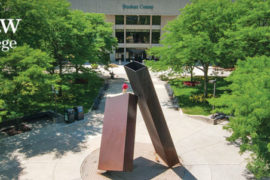The City of Ann Arbor is announcing that construction of two culverts that will divert stormwater underneath the railroad tracks that run along the north side of Depot Street is complete — a major step toward resolving periodic flooding that has long plagued the nearby neighborhood.
At the same time, a pedestrian tunnel adjacent to the stormwater culverts remains on schedule for completion in mid-September. That part of the combined $9.4 million flood mitigation/pedestrian safety project will directly connect the Kerrytown district to the nonmotorized Border-to-Border Trail on the north side of the tracks along the Huron River.
“This is an exciting milestone that will really make a difference in the lives of property owners and residents in the Depot Street area,” said Jerry Hancock, the city’s stormwater and floodplain program manager, who called the Allen Creek Railroad Berm project “the biggest flood mitigation project in city history.”
The addition of the culverts — which measure roughly 200 feet long, 12 feet wide and 7 feet high — will eliminate or greatly reduce flooding risk for dozens of properties on or near Depot Street, said Brian Slizewski, the city engineer overseeing the project.
“We’re effectively lowering the floodplain from 10 feet to 3 1/2 feet, so depending on exactly where the property is, the chances of flooding will be reduced by at least 70%,” he said, adding that flooding will also be less severe when it does occur.
With the stormwater culverts complete, the city will now submit documentation to the Federal Emergency Management Agency requesting a change in the floodplain map in the Depot Street area. That process, which is expected to take at least four months or more, will remove several houses and businesses from the floodplain, eliminating their need to purchase flood insurance or potentially reducing their premiums because of the lowered flood risk, Hancock said.
Ann Arbor Mayor Christopher Taylor is excited about the progress of the project as well as the benefits to the community when completed.
“This project ticks so many boxes for our community,” Taylor said. “It provides a safe link for trail users, provides much-needed flood protection and peace of mind for nearby property owners and could result in lower flood insurance premiums for property owners, with fewer taxpayer dollars going to repair flood damage.”
Under the previous configuration, once the belowground Allen Creek drain reached its capacity, flooding resulted when the railroad berm would block overland flow from reaching the Huron River — a problem that was corrected with the culverts’ installation under the tracks.
The culverts were installed during a 37-hour process that concluded on May 12 and involved removing the tracks, excavating the site, putting precast concrete sections in place, backfilling the excavation and replacing the tracks. The work was finished in time for the Chicago Amtrak train’s evening arrival. Watch the process HERE
The stormwater portion of the project also consisted of laying 286 linear feet of 48-inch pipe to reroute the storm drain in Depot Street through the new culverts.
Construction on the Allen Creek Railroad Berm project got underway in March, nearly 13 years after Hancock proposed the project in the city’s flood mitigation plan. Now it’s a highlight of the city’s new STORMWATER SMA2RT education campaign. The campaign supports Ann Arbor’s commitment to developing forward-thinking, data-driven strategies, embracing today’s advanced technology tools and celebrating the efforts of citizen-volunteers to ensure the city’s stormwater is managed effectively.
“This is definitely one of the more visible stormwater projects that the City of Ann Arbor has ever done,” said Jennifer Lawson, Ann Arbor’s water quality manager. “It took a while for it to move to the top of the city’s list of capital improvement projects, but it’s exciting to see something like this that will have such a huge impact on bettering the community moving toward completion.”
The project will also help the city meet the goal of its recently adopted A2 Zero for achieving communitywide carbon neutrality by 2030, said Eli Cooper, Ann Arbor Transportation Program manager.
“The pedestrian portion of the Allen Creek Railroad Berm project will greatly boost nonmotorized transportation by safely connecting the downtown area to the Border-to-Border Trail,” he said, likening the combination of pedestrian safety and stormwater improvements to a Reese’s Peanut Butter Cup. “By putting two good things together, we created something that was even better.”
The 14-by-9-foot pedestrian tunnel will extend for 85 feet under the railroad tracks, lead to a new bridge over Allen Creek outlet and then connect to the Border-to-Border Trail near the Argo Dam.
The tunnel, in combination with new fencing, will also end the common but dangerous — and illegal — pedestrian practice of walking on or over the tracks, Cooper said.
The Allen Creek Railroad Berm is funded with grants of $3.7 million from FEMA, $970,000 from the Michigan Department of Transportation, $315,000 from SEMCOG and $300,000 from the Michigan Department of Natural Resources, with the remaining 44% — $4.1 million — coming from city coffers.











